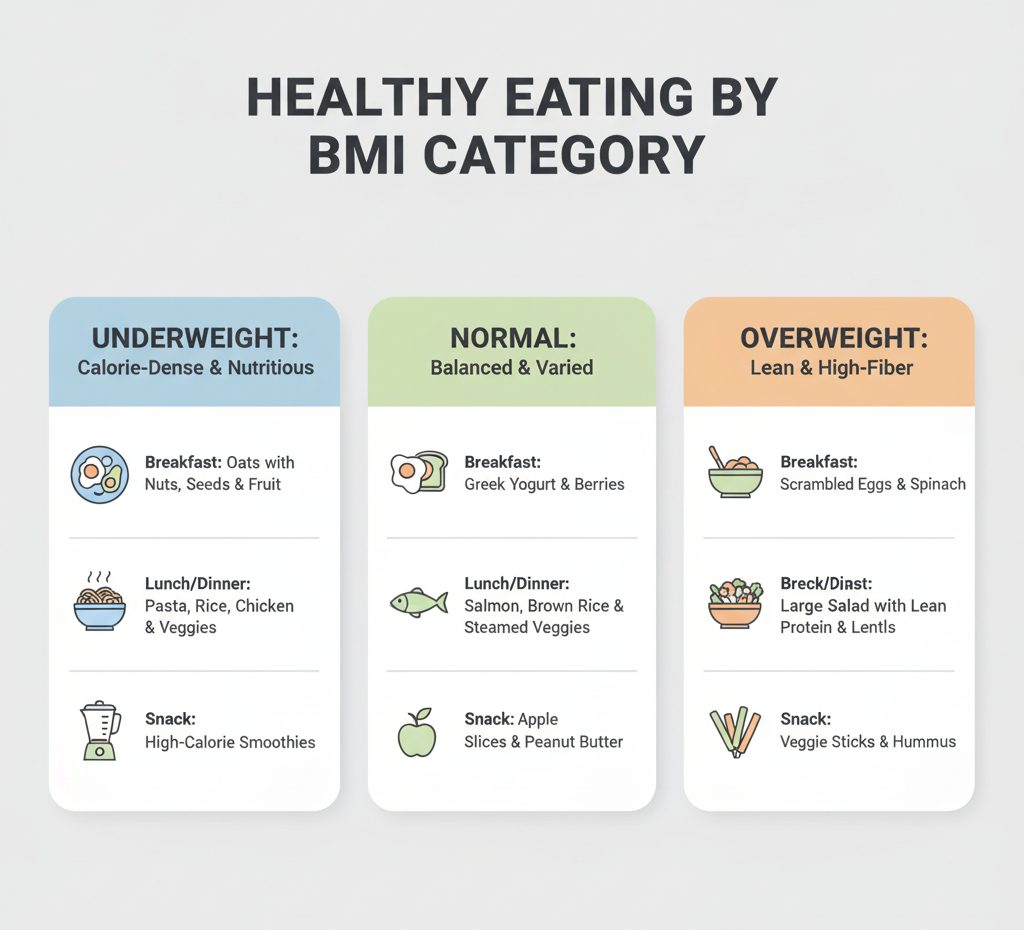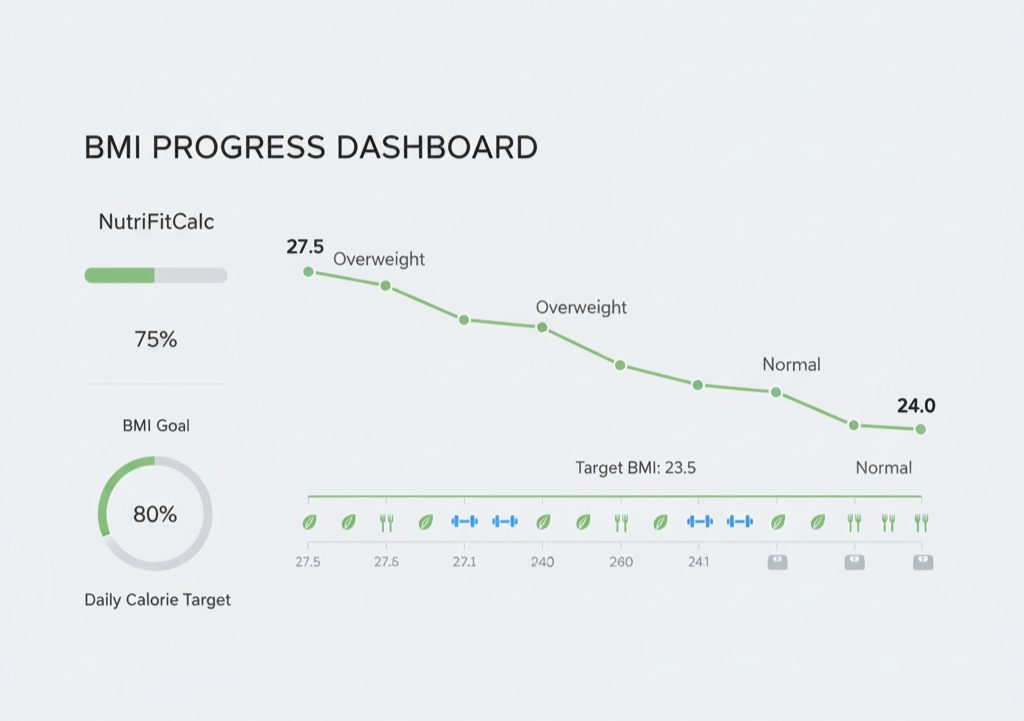Learn how to read your BMI, build the right meal plan for your body, and design a workout routine that matches your goals — without starving yourself or overtraining.
Why Your BMI Can Be a Powerful Starting Point
Have you ever wondered why some people eat less but barely lose fat, while others stay fit without doing “crazy diets”? The answer often comes down to understanding your own body.
Your BMI (Body Mass Index) is more than just a number. It’s a health indicator that helps you understand whether your current weight is generally underweight, healthy, overweight, or in the obese range — and what that means for nutrition and training.
When used correctly, your BMI can guide you toward a meal plan and workout routine that actually fits your body, your energy needs, and your lifestyle. This isn’t about punishment or restriction. It’s about precision — eating smarter, moving with purpose, and building habits that work for you long-term.
What Your BMI Score Really Means
Before you change your diet or workout routine, you need to understand what your BMI is actually telling you. BMI is a simple ratio of weight to height. You can check yours instantly using any online BMI calculator (for example, the NutriFitCalc BMI Calculator).
Common BMI Categories
| Category | BMI Range | Meaning |
|---|---|---|
| Underweight | Below 18.5 | May indicate not getting enough nutrition or muscle support |
| Normal / Healthy Weight | 18.5 – 24.9 | Generally balanced weight for your height |
| Overweight | 25 – 29.9 | Higher body fat levels that may raise health risks over time |
| Obese | 30+ | Increased risk for issues like heart disease or type 2 diabetes |
For general guidance on BMI and health risk categories, see the CDC BMI guidelines (U.S. Centers for Disease Control and Prevention).
Important note: BMI does not measure muscle mass, bone density, or body composition. A very muscular person may have a “high BMI” but low body fat. So think of BMI as a starting point, not a diagnosis.
For a fuller picture, pair your BMI with other tools like a body fat calculator, waist-to-height ratio, or activity-based calorie calculator. The more you know, the smarter you can plan.
Step 1 — Understand Your BMI and Your Body Goals
Your BMI gives you a location on the map. Your goals tell you where you're trying to go.
- If your BMI is below the healthy range: You may need more calories and nutrients to support energy, immunity, and muscle strength.
- If your BMI is in the healthy range: Focus on maintaining balance — steady nutrition, regular activity, strong sleep habits. The goal is “stay strong,” not “get smaller.”
- If your BMI is high (overweight or obese range): This is not failure. It’s a signal. Your body is asking for supportive, gradual changes that improve metabolic health and lower stress on your heart and joints.
Your body needs fuel. Extremely low-calorie crash diets can slow your metabolism and increase cravings. Extremely high-calorie eating can drive fat gain. The win is in the middle: enough nutrition to power your day and still move toward your goal.
Instead of “I have to be skinny fast,” think: more strength, more energy, better stamina, calmer mood. That mindset shift alone makes your plan last longer than any short-term diet challenge.
Step 2 — Turn Your BMI Result Into a Meal Plan
Your BMI result should guide your nutrition strategy, not scare you. After you calculate your BMI, the next move is building a smart meal pattern that supports your specific category.

1. Underweight (BMI below 18.5)
Goal: healthy weight gain and strength. You’re not just “eating more” — you’re feeding muscle and overall recovery.
- Proteins: eggs, chicken, salmon, fish, beans, tofu, milk, Greek yogurt
- Carbs: brown rice, potatoes, oats, whole-grain bread, quinoa
- Healthy fats: nuts, seeds, peanut butter, olive oil, avocado, almonds
Tips: Eat 5–6 smaller meals daily, add smoothies/shakes, and choose whole foods — not just junk calories. Aim to build lean muscle, not just gain body fat.
2. Healthy / Normal Weight (BMI 18.5–24.9)
Goal: maintain balance, steady energy, and avoid slow “creep” weight gain.
- Proteins: chicken breast, fish, lentils, tofu, yogurt
- Carbs: quinoa, brown rice, sweet potato, fruits, vegetables
- Fats: chia seeds, almonds, flaxseeds, olive oil
Tips: Many people aim for something like a 40/30/30 ratio (carbs/protein/fats). Eat slowly, stay hydrated, and watch mindless snacking. NutriFitCalc-style nutrition and macro calculators can help you keep this balance day to day.
3. Overweight / Obese (BMI 25+)
Goal: support fat loss safely — not starve. You want steady calorie control, higher protein, higher fiber, and stable blood sugar.
- Proteins: lean meats, eggs, grilled fish, lentils, beans
- Carbs: vegetables, legumes, whole grains, sweet potato (dense but nutrient-rich)
- Fats: avocado, walnuts, olive oil (in moderation)
Tips: Cut sugary drinks and ultra-processed snacks. Eat more fiber-rich vegetables. Use calorie and macro tracking tools to understand portions instead of guessing.
See how this works? You’re not “on a diet.” You’re eating in a way that supports what your body is asking for, based on where you are right now.
Sample Meal Ideas for Each BMI Category
Here are simple daily meal examples to help you translate BMI guidance into real food choices.
For Underweight BMI (Goal: gentle weight gain & strength)
- Breakfast: Oatmeal cooked in whole milk + peanut butter + banana slices
- Lunch: Grilled chicken breast + brown rice + sautéed veggies
- Snack: Greek yogurt with honey and nuts
- Dinner: Salmon + mashed potatoes (with olive oil) + steamed broccoli
- Bonus fuel: A glass of milk or a protein smoothie before bed
For Normal BMI (Goal: maintain energy & prevent slow gain)
- Breakfast: Veggie omelet + whole-grain toast
- Lunch: Quinoa salad with chickpeas, avocado, olive oil dressing
- Snack: Apple + almond butter
- Dinner: Baked fish + sweet potato + green beans
- Hydration tip: Water or herbal tea between meals helps prevent “boredom eating”
For Overweight BMI (Goal: steady fat loss, no crash)
- Breakfast: Scrambled eggs + spinach + whole-grain toast
- Lunch: Stir-fried vegetables with tofu or grilled chicken
- Snack: A handful of nuts or a fresh fruit bowl
- Dinner: Lentil soup + light salad + lemon water
These “BMI-aware” meals are higher in protein and fiber and lower in empty sugar. That keeps you full longer and supports slow, steady fat loss.
Step 3 — Use Your BMI Result to Plan Workouts
Your training should match your body’s needs — not a random internet routine. BMI can help point you in the right direction for movement, cardio, and strength work.

If You’re Underweight (BMI < 18.5)
- Main goal: build strength and lean mass
- Do more: bodyweight squats, push-ups, dumbbell presses, resistance band work, planks, side bridges
- Light cardio: brisk walking or gentle cycling (15–20 min) to stay active, not to burn off calories you actually need
- Tip: Train ~4–5 days/week, and eat protein after each session for recovery
If You’re in the Healthy Range (BMI 18.5–24.9)
- Main goal: maintain strength, mobility, and cardiovascular health
- Suggested mix: light strength training, lunges, push-ups, yoga, light jogging, or short HIIT 1–2x/week
- Key idea: consistency is more important than intensity
If You’re Overweight or Obese (BMI 25+)
- Main goal: improve metabolism safely while protecting your joints
- Focus on: low-impact cardio such as walking, cycling, or swimming ~30 min/day
- Add: light strength work (bodyweight or light weights) and core stability (bridges, gentle Pilates)
- Stretch/Yoga: helps mobility, reduces joint stress, and lowers tension hormones like cortisol
No matter your BMI range, the rule is the same: start where you are. Then build slowly. Your plan should feel supportive, not punishing.
Step 4 — Monitor Progress and Adjust Regularly
Your body will change as you get healthier — which means your plan should evolve too.
- Re-check your BMI every 4–6 weeks. That gives enough time to see real changes without obsessing daily.
- Track more than weight: watch your waist size, energy levels, stamina, mood, and sleep quality.
- Use calculators (BMI, calories, macros) to update your targets as you gain muscle or lose fat.
If your BMI moves toward a healthier range or you’ve built noticeable strength, you may need to:
- Increase calories slightly (if you were underweight)
- Reduce your calorie deficit a bit (if weight loss has slowed too much)
- Increase workout intensity slowly (if you're getting stronger and want more challenge)

Think of BMI as a guidepost — not a grade. You are not chasing a number. You’re building a healthier, stronger version of yourself.
Step 5 — Make It a Lifestyle, Not a Short-Term Fix
Real progress isn’t about crash diets or 30-day challenges. It’s about the small actions you repeat daily:
- Drink more water and stay hydrated.
- Walk more throughout the day, not just “work out” once.
- Prepare simple, balanced meals at home most days of the week.
- Get back on track after off days instead of quitting completely.
Your BMI is not just a label. It’s a snapshot of where you are today — and a reminder that you can keep improving with consistent effort.
Celebrate real wins: better sleep, more stamina, less stress eating, looser clothes, stronger mood. Those are powerful signs that your health is moving in the right direction.
Healthy living is a long-term partnership with yourself. Stay active. Keep learning. Be kind to your body. If you’re ready to start, get your current number using a trusted BMI Calculator and build from there.
1. Is BMI a good measure for fitness? +
Treat BMI as a guide, not a judgment. For best results, compare it with other data like waist size, strength, and body fat percentage.
2. Can I plan my meals based on BMI? +
• Underweight: calorie-dense, high-protein meals to promote healthy weight gain.
• Healthy range: balanced macros to maintain energy and prevent slow weight creep.
• Overweight/obese: high-fiber, high-protein, controlled-calorie meals that help burn fat safely.
Tools like macro and calorie calculators make this much easier to personalize.
3. How often should I check my BMI? +
Checking daily or every few days can be discouraging and misleading because normal water shifts can move the scale.
4. What’s better: BMI or body fat percentage? +
• BMI = big-picture category (underweight / healthy / overweight / obese).
• Body fat % = your actual body composition, including how much of you is fat vs. muscle.
Using both together gives you a more honest view of your health and progress.
About the Author
This article is written by the NutriFitCalc Team, a group of Food Science and Nutrition students who create simple, research-backed guides for healthy living.
We review global health sources like WHO and CDC to keep our content accurate and helpful.
